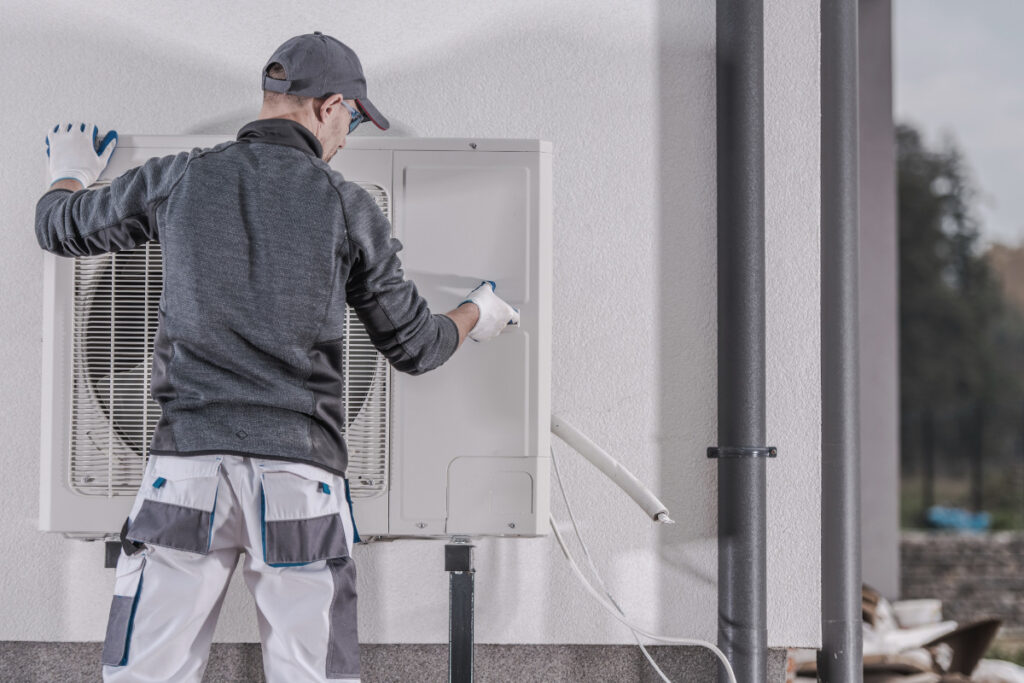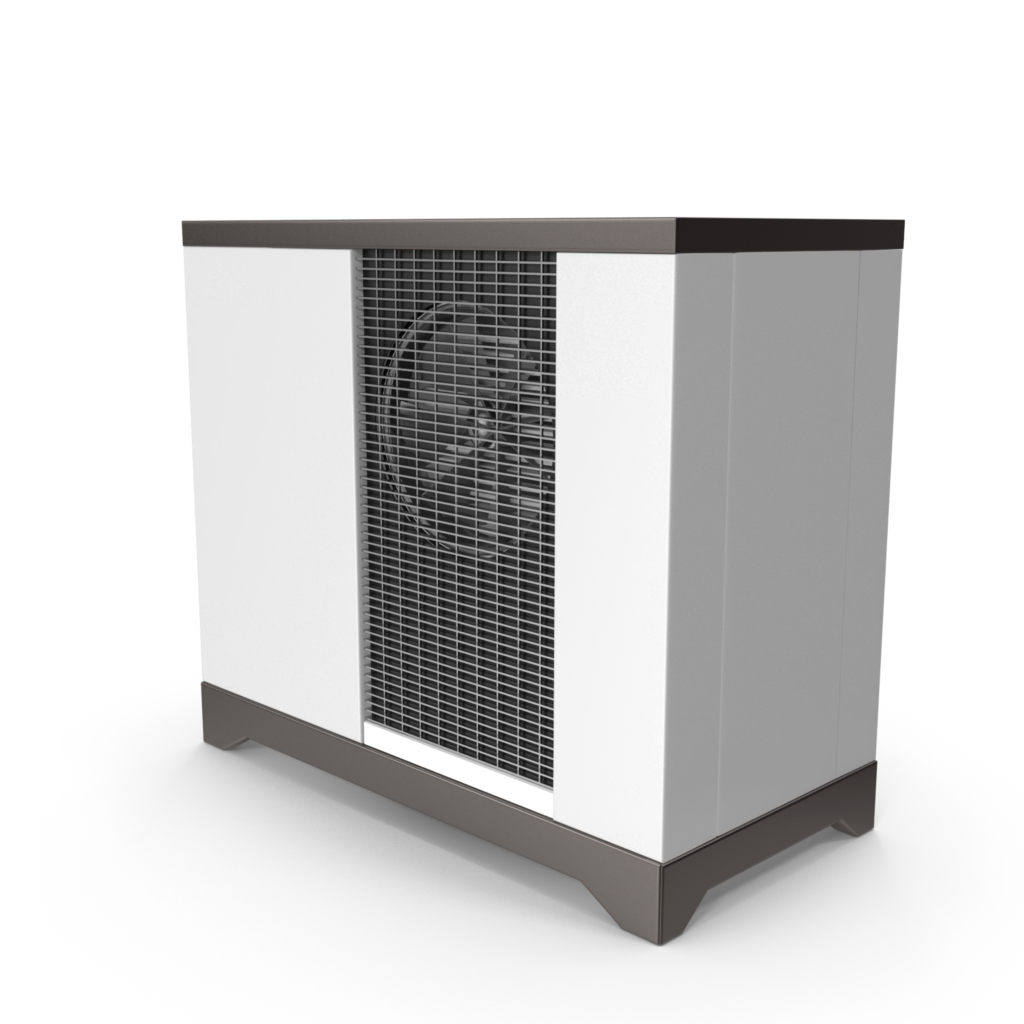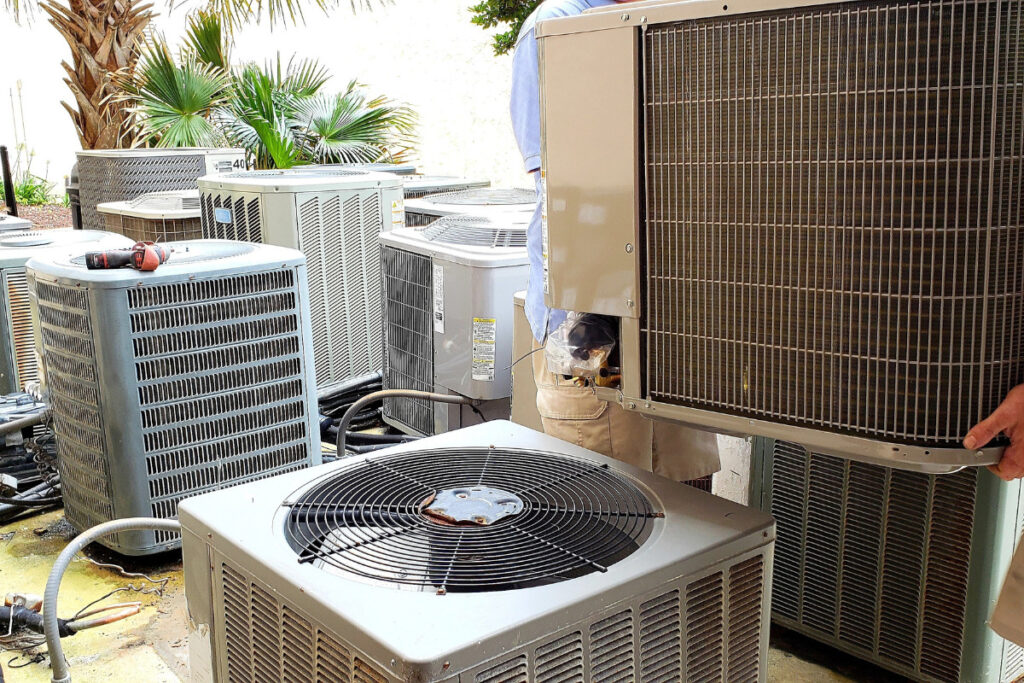Introduction
As the demand for energy-efficient and sustainable heating solutions grows, heat pumps are becoming an increasingly popular choice in various regions across the United States. HVAC systems save energy and reduce carbon footprints while providing consistent indoor comfort throughout the year.
This comprehensive blog post will explore different types of heat pumps, their benefits based on specific regional climates, factors to consider before making a purchase decision, and much more. So let’s understand how heat pumps can revolutionize residential and commercial heating in your region!

Understanding Heat Pumps And Their Benefits
Heat pumps are a type of HVAC technology that transfers thermal energy from the air outside to heat or cool indoor spaces, with benefits including improved energy efficiency and lower carbon footprints.
Definition Of Heat Pumps
Heat pumps are an innovative HVAC technology that provides heating and cooling capabilities in one efficient system. They transfer thermal energy between indoor and outdoor environments instead of creating heat like a traditional furnace or air conditioner. This unique process makes them highly efficient, using less energy than most other heating systems while maintaining optimal comfort levels in your home.
Heat pumps use electricity to move thermal energy from one space to another. It absorbs warmth from the outside air and transfers it into the home for increased comfort. In warmer seasons, the reverse occurs – it extracts excess heat from indoors and releases it outdoors for effective cooling. Electric heat pumps are becoming increasingly popular for homeowners seeking reliable climate control solutions with lower carbon footprints and reduced energy costs.
Advantages Of Heat Pumps
Heat pumps offer numerous benefits for homeowners and businesses, making them popular for those seeking energy-efficient heating and cooling solutions. Some key advantages of heat pumps include:
- Energy Efficiency: Heat pumps use electricity to heat homes, making them more energy-efficient than traditional furnaces and air conditioners.
- Cost Savings: Reduced energy consumption leads to lower utility bills for property owners, contributing to long-term cost savings.
- Environmentally Friendly: Heat pumps reduce carbon emissions and contribute to climate change mitigation efforts by using renewable energy sources.
- Versatility: Heat pumps can provide heating and cooling functions in one system, offering year-round comfort regardless of the season.
- Wide Range of Applications: Heat pumps can be used in various settings, making them suitable for diverse needs.
- Improved Air Quality: Heat pumps improve indoor air quality by removing allergens, dust particles, and pollutants from the air.
- Low Maintenance Requirements: Heat pump systems typically require less maintenance than traditional HVAC systems due to their fewer moving parts.
- Quiet Operation: Heat pumps operate with minimal noise levels, ensuring a peaceful living environment in residential settings.
- Long Lifespan: Heat pump systems can last up to 15 years, offering property owners an excellent return on investment.
10. Geothermal Options: Ground source heat pumps utilize geothermal energy as a sustainable heating and cooling source. This environmentally friendly option contributes further to reducing your carbon footprint while saving energy costs.
Types Of Heat Pumps
There are three main types of heat pumps: air source, ground source, and hybrid. Discover their differences and determine which is best suited for your region. Keep reading to learn more!

Air Source Heat Pumps
Air source heat pumps have become an increasingly popular choice for homeowners across the United States, primarily due to their energy-efficient properties and cost-effective heating solutions. These systems extract heat from the outdoor air and transfer it indoors through refrigeration, providing consistent warmth to homes in moderately cold climates.
A major advantage of air source heat pumps is their versatility, as they can also function as cooling systems during warmer months. They are relatively easy to install compared to ground source or geothermal options and typically have a lower upfront cost. This makes them ideal for homeowners looking for an affordable yet environmentally friendly heating solution. For example, states like Florida and Texas have seen a significant increase in the use of air-source heat pumps due to their efficient performance in temperate climates. Additionally, air-source heat pumps contribute to lowering carbon footprints while achieving notable energy savings – factors that make them an attractive option for those aiming at sustainable living practices in various regions nationwide.
Ground Source Heat Pumps
Ground source heat pumps (GSHPs) are another heat pump that utilizes the earth’s natural warmth to provide heating and cooling. GSHPs work by circulating a fluid through pipes buried in the ground, absorbing the earth’s heat and transferring it into your home. These systems can be installed vertically or horizontally in yards or fields.
One advantage of GSHPs is their longevity; they have an average lifespan of 25 years and require minimal maintenance compared to traditional HVAC systems. Additionally, GSHPs have high energy efficiency ratings due to their reliance on renewable geothermal energy, making them an environmentally friendly option for homeowners looking to reduce their carbon footprint.
However, one potential drawback of installing a GSHP system is the upfront installation cost, which tends to be more expensive than other heating and cooling systems. Ultimately, choosing a heating and cooling system depends on various factors like climate and budget constraints but considering ground-source heat pumps as an option may be worthwhile for those interested in long-term sustainability benefits.
Hybrid Heat Pumps
Hybrid heat pumps are a relatively new heating technology that combines the best of both worlds. They use electricity and natural gas for an even more efficient and cost-effective system than traditional air-source or ground-source heat pumps.
The hybrid system works by switching between electric power when temperatures are moderate and gas power during extreme temperature drops. This allows homeowners to take advantage of cheaper electricity rates while still having the reassurance of a reliable source for heating in freezing conditions without worrying about high heating bills.
Hybrid heat pump systems have become increasingly popular in areas where energy costs fluctuate throughout the year, making them especially useful in the Midwest and Mountainous states. These systems also help residents reduce their carbon footprint by using renewable sources such as solar or wind to generate electricity to power these hybrid units.
Regional Differences In Heat Pump Use In The US
Different regions of the United States have varying factors that influence heat pump usage, from climate and weather patterns to availability of renewable energy sources – discover which region suits your heating needs best. Read on to learn more about Heat Pumps By Region In The United States!
Factors Influencing Heat Pump Usage In Each Region
Several factors influence the usage of heat pumps in different regions of the United States. Firstly, climate and weather patterns play a significant role. For example, areas with milder winters, like the Southern States, rely more on air-source heat pumps than ground-source heat pumps. This is because air source heat pumps work efficiently in moderate temperatures between 25°F to 45°F.
Secondly, energy efficiency standards and regulations vary by region. Some states offer incentives for using renewable energy sources like geothermal heating systems or may require new constructions to install heat pumps instead of traditional HVAC systems.
Lastly, the cost of electricity and natural gas also affects consumers’ preferences for heating options at home. Regions with more expensive electricity tend to rely more heavily on hybrid heat pump systems that utilize electric and natural gas heating elements during peak demand. Meanwhile, southern coastal states with cheap electricity favor all-electric HVAC units that are highly efficient during cooling seasons but less economical for winter months.
The regional differences in factors influencing heat pump usage highlight how individual consumer needs often translate into diverse adoption patterns across America’s geography – from those prioritizing affordability over environmental impact versus those striving for long-term sustainability solutions, each household has its unique characteristics shaping what makes sense for their family’s comfort levels as well as budget constraints.
Northern States
The Northern States of the US experience colder and longer winters compared to other regions. This makes heating systems an essential part of every household. Regarding heat pump usage, air-source heat pumps are more commonly used in these states due to their cost-effectiveness and ability to operate efficiently in moderate temperatures. Ground source heat pumps may also be utilized in areas with extreme cold weather conditions.
Energy efficiency standards and regulations differ from state to state, but generally, it is recommended for households in the Northern States choose a heat pump that meets or exceeds ENERGY STAR® requirements for optimal energy savings. Another consideration is the availability of renewable energy sources like solar panels or wind turbines, which can offset some electricity costs for a heat pump system.
Overall, using a heat pump offers several benefits for homeowners in the Northern States, such as a lower carbon footprint and reduced energy costs. With advancements in technology and increasing awareness about sustainable living solutions, we can expect more households across all regions of the US to switch over to efficient HVAC systems like geothermal or electric heating options, including hybrid models.
Southern States
The Southern States region of the United States has a warm and humid climate for most of the year. Due to this, heat pumps are highly popular in this region as they provide an energy-efficient solution for air conditioning needs. Air-source heat pumps are prevalent in this area, primarily due to their affordability compared to other heat pumps. Furthermore, relatively cheap electricity in these states makes electric-powered heat pumps a cost-effective option.
However, high humidity levels can sometimes pose challenges when using a heat pump system. Traditional air-source heat pumps may not be efficient enough when temperatures drop below freezing point during winter since they might lose efficiency under extremely cold conditions. In such cases, ground-source or hybrid heat pump systems that work efficiently even at very low outdoor temperatures can be used as an alternative.
Despite some potential downsides associated with using Heat Pumps in the Southern States regions, like noise pollution caused by outdoor units and expensive installation costs for geothermal heating systems, their benefits still outweigh these issues by far— providing improved indoor comfort while being environmentally friendly and energy-efficient alternatives for households across America’s southern states.
Coastal States
Coastal states, such as California and Florida, have distinct climate conditions that make heat pump use unique. Air-source heat pumps are the most commonly used in regions with high humidity and temperatures. These systems work by drawing in hot outdoor air and cooling it using refrigerant before distributing it throughout a home or office. Additionally, ground-source or geothermal heat pumps can be an excellent solution for coastal areas where soil temperatures remain relatively constant.
In recent years, many homeowners in coastal states have also started to install mini-split ductless systems for improved energy efficiency and heating control. The state of California’s Climate Zone program provides guidelines for building codes based on geographical location to ensure proper heating, ventilation, and air conditioning equipment is installed in homes across the area.
In conclusion, Coastal States provide unique opportunities for heat pump technology due to their specific weather patterns, such as humidity levels are typically higher than in other regions. Innovative energy solutions like air source heat pumps combined with standards from building code programs like those provided in California offer great potential energy savings benefits while keeping costs low through reduced electricity usage throughout these regions when compared to traditional furnace or boiler heating has been gaining popularity among homeowners seeking sustainable living options through renewable energies such as HVAC-equipped geothermal systems matching favorable temperature settings along with zoning done correctly will ensure optimal performance resulting not only environmental-friendly but cost-effective comfort all year round.
Mountainous States
Mountainous states such as Colorado and Wyoming have unique heating and cooling requirements due to their high elevation and extreme temperature fluctuations. Traditional HVAC systems often use heat pumps in these areas to provide efficient heating during the colder months. Additionally, ground-source heat pumps can be an effective solution for mountain homes as they use stable underground temperatures to provide consistent indoor heating.
However, natural gas remains a popular choice for home heating in some mountainous regions due to its affordability compared to electricity. Despite this, recent advancements in super-efficient electric heat pumps may make them a more cost-effective and sustainable option in the long run. Solar-powered heat pumps are becoming more widely available for those seeking a renewable energy option and can help offset energy costs while reducing carbon emissions.
When considering purchasing or upgrading a heating system in mountainous states, it is important to consider factors such as climate patterns, availability of renewable energy sources like solar power or geothermal systems, and local regulations related to energy efficiency standards. By carefully weighing these considerations and consulting with knowledgeable professionals in the field of HVAC technology and green building design, homeowners can ensure that they make an informed decision that maximizes comfort while minimizing environmental impact.
Midwest States
The Midwest States are known for their harsh winters and hot summers, which make heating and cooling systems a must-have in every household. Heat pumps have become increasingly popular in the region due to their energy efficiency and cost-effectiveness. In fact, the US Department of Energy reports that heat pumps can save homeowners up to 50% on their annual energy bills compared to traditional heating systems.
States like Ohio, Illinois, and Michigan have been actively promoting using ground source heat pumps (GSHPs), also known as geothermal systems, as they offer significant benefits over conventional HVAC units. With GSHPs, homeowners can reduce their carbon footprint by up to 72%, thanks to the renewable energy source used for operation. Moreover, these innovative systems provide consistent indoor comfort regardless of outdoor temperatures or weather conditions.
The National Renewable Energy Laboratory estimates that about 33% of homes in Illinois could benefit from installing a GSHP system due to its favorable soil temperature range. Additionally, many Midwestern states offer incentives such as tax credits or rebates for households looking to upgrade or replace inefficient heating and cooling equipment with more sustainable options like heat pumps.
Factors To Consider When Choosing A Heat Pump By Region
When choosing a heat pump by region, factors include climate and weather patterns, energy efficiency standards and regulations, electricity and/or natural gas costs, and availability of renewable energy sources.

Climate And Weather Patterns
Climate and weather patterns are critical factors in determining the ideal type of heat pump for a specific region. In northern states, where winter temperatures can drop below freezing, ground-source heat pumps (GSHPs) are more commonly used than air-source heat pumps (ASHPs). GSHPs extract geothermal energy from the earth’s constant temperature to provide warmth in the winter and coolness in the summer. ASHPs may struggle with extremely cold temperatures, leading to higher electricity bills.
In coastal regions with high humidity levels, homeowners should consider ductless ASHPs that can dehumidify indoor air while cooling it down. This system is particularly useful during hot summers when humidity levels rise but not enough to necessitate full air conditioning. On the other hand, mountainous regions typically require hybrid or dual-fuel systems that combine an electric-powered heat pump with a natural gas or propane heating source since winters tend to be colder and longer. Hybrid systems usually include backup burners that only activate when outdoor temperatures dip below a certain level.
In summary, know regional climate and weather patterns to choose the best heat pump for your home or business. Choosing the right model for your location will ensure long-term energy savings and consistent indoor comfort.
Energy Efficiency Standards And Regulations
Energy efficiency standards vary by region, impacting the type of heat pump homeowners can install. For example, in California, heat pumps must meet minimum SEER (Seasonal Energy Efficiency Ratio) requirements to be considered energy-efficient. On the other hand, some regions have no specific requirements or limitations on heating and cooling systems.
Homeowners should consider regulations when choosing a heat pump, which can impact upfront costs and long-term savings. A more efficient heat pump may have a higher initial cost but provides greater long-term savings through reduced energy consumption. Conversely, a more affordable but less efficient option may be sufficient in areas with fewer regulations or lower electricity rates.
It is essential to comprehend regional efficiency standards and regulations. This knowledge helps you choose an energy-efficient heat pump that offers comfort while reducing energy costs and environmental impact.
Cost Of Electricity And/or Natural Gas
The cost of electricity and natural gas is important when choosing a heat pump. Generally, areas with higher electricity costs make air-source heat pumps less cost-effective than other heating systems. For example, Hawaii and Alaska have the highest electricity rates due to their remote locations and dependence on imported fuels.
On the other hand, Electric-powered heat pumps can reduce operating costs in low-cost regions. Natural gas prices determine which type of heat pump is best for a home or business. Ground-source heat pumps provide efficient heating and cooling without fluctuating fuel prices.
Understanding electricity and natural gas pricing trends helps homeowners reduce energy consumption while reducing carbon footprints. Consumers should monitor utility rates to make informed decisions about energy-efficient appliances.
Availability Of Renewable Energy Sources
When choosing a heat pump by region, it’s important to consider the availability of renewable energy sources. Renewable energy is becoming increasingly popular in the US, and installing a heat pump can reduce carbon footprint. California and Hawaii have ambitious renewable energy goals, making them ideal for renewable-powered heat pumps.
In addition, some states offer incentives and rebates for installing renewable energy systems such as solar panels or wind turbines. These incentives can help offset the cost of purchasing and installing a heat pump compatible with these technologies. For example, New York State offers rebates of up to $6,000 for ground-source (geothermal) heat pumps linked to renewables.
Renewable energy options reduce reliance on fossil fuels and save on utility bills. It’s important to research local regulations and programs when evaluating alternatives to traditional heating systems. More homeowners will choose sustainable options in the future.

Benefits Of Using Heat Pumps By Region
Heat pumps offer reduced energy costs, indoor comfort, and a lower carbon footprint. Read on to discover how you can benefit from this innovative HVAC technology.
Reduced Energy Costs
Heat pumps are a cost-effective alternative to traditional heating and cooling systems, offering significant energy savings for homeowners. Heat pumps also use electricity to transfer thermal energy, saving energy. This efficiency reduces energy costs and lower utility bills, especially compared to conventional HVAC systems.
In addition to lower operating costs, many states offer rebates and tax incentives for installing high-efficiency heat pumps. Homeowners can reduce their carbon footprint and enjoy greater indoor comfort by switching to a heat pump system. Heat pump systems are becoming increasingly popular in the US, allowing households to benefit from reduced energy costs.
Consistent Indoor Comfort
Heat pumps provide consistent indoor comfort throughout the year, regardless of the outside temperature. This is because they maintain a constant level of heating or cooling to keep indoor temperatures steady. The following are some ways that heat pumps provide consistent indoor comfort:
- Heat pumps have adjustable fan speeds allowing customized airflow and temperature control.
- They can operate in various modes to meet specific needs, like heating, cooling, and dehumidifying.
- Heat pumps offer quiet operation compared to other HVAC systems, ensuring an undisturbed living space.
- They feature programmable thermostats that enable users to set the desired temperature and schedule adjustments based on their routine.
- Heat pumps provide air filtration systems to reduce dust particles and allergens, improving indoor air quality.
- Heat pump models have automatic defrost features to prevent frost buildup during cold weather, providing consistent performance without interruption.
Overall, heat pumps offer reliable and efficient indoor climate control that provides homeowners a comfortable living environment all year round.

Lower Carbon Footprint
One of the most significant benefits of using heat pumps is that they help reduce carbon footprint. Unlike traditional heating and cooling systems, heat pumps use electricity to move thermal energy from one place to another.
Replacing an old HVAC system with an efficient electric heat pump can save up to 50% on household energy bills. It can also reduce carbon dioxide emissions by around 1.5 tons per year, according to the Environmental Protection Agency (EPA). This helps homeowners save money and significantly creates a more sustainable future.
In addition, some states in the US offer tax credits or incentives for installing high-efficiency heat pumps, making it even more financially attractive for households looking to reduce their carbon footprint while saving money in the long run.
The Future Of Heat Pumps In The United States And Conclusion
In conclusion, the future of heat pumps in the United States is bright. Americans are increasingly turning to green technology for their heating and cooling needs. With steady growth in the industry since 2010, sales of super-efficient electric heat pumps are on the rise. Furthermore, regional differences in heat pump usage reflect climate patterns and energy availability in each area. Heat pumps are essential for sustainable home design and a reduced carbon footprint. So whether you live in the northern states or coastal regions, consider switching to a renewable energy source for your HVAC needs – it’s good for the planet and your wallet!
Want to go solar
At DroneQuote, we are committed to helping you transition to sustainable and efficient energy solutions. With our cutting-edge drone technology, we can provide you with accurate measurements and quotes quickly and easily, saving you time and money. Don’t wait any longer to switch to a renewable energy source for your HVAC needs. Sign up today by clicking here.

[…] for HVAC systems that have high Seasonal Energy Efficiency Ratio (SEER) ratings and Heating Seasonal Performance […]